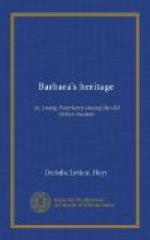“Look out for Crivelli’s Madonnas, and all of Paul Veronese’s work. He was really the most utterly Venetian painter who ever lived. He painted Venice into everything: its motion, its color, its intoxicating fulness are all found in his mythological and banquet scenes. You will find his pictures in the Ducal Palace, in the Academy, and a fine series in San Sebastiano, which represents legendary scenes in the life of St. Sebastian. Go to Santa Maria Formosa and look at Palma Vecchio’s St. Barbara, his masterpiece. You will also find several of this artist’s pictures in the Academy worth looking at. His style at its best is grand, as in the St. Barbara, but he did not always paint up to it, by any means.
“As to the rest, study them as a whole. The Venice Academy is an epitome of Venetian painting, from its earliest work down through the High Renaissance into the Decadence. It was full of pure and devotional sentiment, rendered with good, oftentimes rich, color, until after the Bellini. Then the portrayal of purely physical beauty, with refinement of line and gorgeousness of color, became preeminent. The works of several artists of note, Palma Vecchio, Palma Giovine, Bonifazio Veronese, and Bordone, so resemble each other and Titian’s less important works, that there has been much uncertainty as to the true authorship of many of them.”
“And Tintoretto?” questioned Barbara.
“I will take you to see Tintoretto’s pictures—or many of them at least,” added Mr. Sumner. “He stands alone by himself.”
Chapter XIX.
In a Gondola.
And on her lover’s
arm she leant,
And round her
waist she felt it fold,
And far across the hills they
went
In that new land
which is the old.
—TENNYSON.
[Illustration: GRAND CANAL AND RIALTO, VENICE.]
Lucile Sherman, accompanied by her friends, had arrived in Venice, and though not at the same hotel, yet she spent all the time she could with Mrs. Douglas, and wished to join her in many excursions. She had found it very wearisome to tarry so long in Rome, but there had been no sufficient reason for following the party to Florence and on to Venice; therefore it had seemed the only thing to do.
Now that she was again with them she watched Mr. Sumner and Barbara most zealously. Her quick eyes had noted the altered condition of affairs during the latter days of the Naples journey, and she was feverishly anxious to understand the cause. Her intuition told her that there was some peculiar underlying interest for each in the other, and when this exists between a man and woman, some sequel may always be expected. One thing was certain; Mr. Sumner covertly watched Barbara, and Barbara avoided meeting his eye. She could only wait, while putting forth every effort to gain the interest in herself she so coveted.




